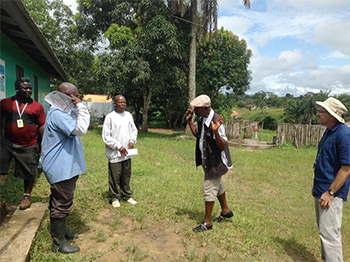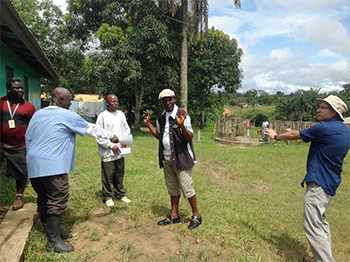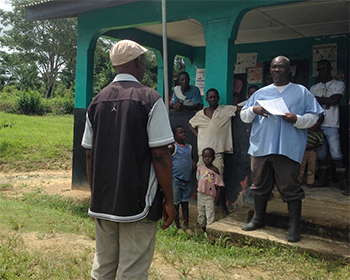Stories From the Field: Brant Goode, RN/BSN, MPH, CDC Career Epidemiology Field Officer

Fig.1a. “My son is sick and needs medicine!” the Gibi District Superintendent tells the Weala Clinic Officer in Charge (OIC). (Photo credit: Miwako Kobayashi, CDC EISO. All persons provided verbal consent to being photographed.)

Fig.1b. “Wait there. I need to ask you some questions…” The Clinic OIC directs the father of the patient to wait before entering the clinic. The OIC triages the patient, notes probable EVD and directs the patient and father to enter the clinic in a different area. (Photo credit: Miwako Kobayashi, CDC EISO. All persons provided verbal consent to being photographed.)

Fig 1.c. This image shows the clinic’s waiting area behind the OIC where multiple patients wait for care. Allowing uncontrolled access by patients with suspected EVD into a common waiting area poses risks to patients and HCWs. Here the OIC practices telling a suspected EVD patient’s father to bring his son to another entrance where suspect and probable EVD cases can be isolated and cared for while awaiting transfer to an ETU. (Photo credit: Miwako Kobayashi, CDC EISO. All persons provided verbal consent to being photographed.)
As the world is witnessing, Liberia is experiencing severe impact from Ebola among both the general population and healthcare workers. Around the time of my deployment, 18 of 24 infected healthcare workers at the C.H. Rennie Hospital in Kakata died from Ebola, including the lead infection preventionist. To be sure, this scenario heightened the world’s urgency to slow and stop the spread of Ebola. I knew that I could help.
After undergoing training at CDC headquarters in Atlanta, I traveled to Liberia to aid infection prevention and control (IPC) efforts. My work included training healthcare workers and community members, providing expert technical assistance to Government of Liberia personnel, and consulting with partners including the World Health Organization (WHO), UNICEF, and Save the Children.
One of the things that surprised me most as I traveled from clinic to clinic in Liberia was the emphasis on the use of personal protective equipment (PPE) for infection control. With over 25 years of experience, I knew that while PPE is important, there are other important IPC measures, and these other measures were not being as actively embraced. IPC efforts should include safe practices that remove hazards to begin with, and I was concerned that if facilities didn’t implement these IPC measures in addition to PPE, case counts would increase and the facilities’ already limited resources would be stretched even further.
There are many things that should be emphasized in training personnel. When visiting outlying clinics, I taught personnel how to apply some of these IPC measures effectively. At the Weala Clinic, I used a role-playing exercise to teach the clinic’s Officer in Charge (OIC) how to assess patients for Ebola before they entered the clinic’s waiting area:
“My son is sick and needs medicine!” said the father of a patient.
The OIC stopped him at a distance from the clinic. “Wait there a moment. What’s wrong with your son?”
The OIC stepped forward to triage the patient while maintaining a distance of at least two meters from him. From this, he was able to conclude that the patient met the probable case definition for Ebola. The OIC then directed both the patient and father to a different clinic entrance area specifically for Ebola patients. This protected other patients in the waiting area from potential exposure, as well as clinic staff.
One of the easiest and most important things facility managers can do is to strictly control access to clinics and hospitals (an engineering control) using fences where needed and choosing triage points that are located outside of the facility itself. This is especially important in areas where PPE is limited. I found that the C.H. Rennie Hospital had already instituted this kind of system by using chain-link fences with security and a single triage point. I urged another hospital to similarly triage patients at a separate location and they agreed it made sense to do so.
These are just some examples of how successfully prioritizing IPC efforts can lead to reduced transmission risk and better work flow. Measures such as identifying and training IPC leaders within healthcare facilities, implementing engineering controls such as fences to control access, determining appropriate locations to provide care to Ebola patients, and training other personnel to implement appropriate work practices should receive high priority if we are to save lives.
- Page last reviewed: January 5, 2015
- Page last updated: January 5, 2015
- Content source:




 ShareCompartir
ShareCompartir